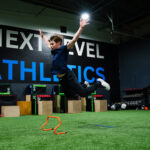How Speed and Agility Training Boosts Athletic Brainpower
Most athletes train their bodies. The great ones train their minds too. What if we told you speed and agility workouts don’t just improve movement — they sharpen mental performance?
In today’s high-performance world, athletic success is just as mental as it is physical. This article explores how speed and agility training enhances cognitive function, reaction time, and decision-making on and off the field.
Movement and the Brain: The Hidden Connection
Athletes make hundreds of decisions in a single game. They must:
-
React in milliseconds
-
Anticipate opponents’ moves
-
Shift strategies on the fly
Speed and agility training helps develop these skills. How? Because rapid movement engages the brain’s executive function, the part responsible for processing information, attention, and quick choices.
Every sprint, cut, and shuffle forces the brain to process stimuli and command a response — fast.
How Speed and Agility Activates the Brain
Here’s how it works:
1. Multisensory Processing
Agility drills often involve external cues — whistles, lights, or coach commands. These train the brain to process and respond to multisensory input, just like in real gameplay.
2. Reaction Time Enhancement
Quick direction changes under pressure enhance reaction speed. The brain builds faster communication between neurons to execute decisions efficiently.
3. Motor-Cognitive Integration
Complex movement patterns strengthen the connection between your muscles and mind. The result? Improved balance, body control, and situational awareness.
Smart Drills That Train Body and Brain
You don’t need to choose between physical and mental training. These drills improve both:
1. Agility Lights Reaction Drill
Focus: Reaction speed, visual processing, footwork
How to Perform:
-
Set up agility lights (or use a partner with colored cones).
-
When a light or color flashes, sprint or shuffle toward it.
-
Use unpredictable timing to simulate game scenarios.
This engages the visual cortex and challenges motor response time.
2. Mirror Shuffle with Fake Outs
Focus: Decision-making under pressure
How to Perform:
-
Face a partner in athletic stance.
-
Partner moves laterally; you mirror their movement.
-
They add fake movements — your job is to stay synced.
This sharpens reading cues and reacting instantly.
3. Dual-Task Ladder Drills
Focus: Foot speed and cognitive multitasking
How to Perform:
-
Perform ladder foot drills (in-in-out, Ickey shuffle, etc.).
-
At the same time, solve simple math problems or respond to verbal cues.
This forces the brain to split focus — just like it does in sports.
Neurological Benefits of Speed and Agility Training
According to Healthline, intense physical activity like speed training increases brain-derived neurotrophic factor (BDNF) — a protein that supports cognitive function and memory.
Additional benefits include:
-
Sharper focus under fatigue
-
Faster reaction times in game situations
-
Better stress regulation through improved executive function
-
Greater pattern recognition during live play
These outcomes directly impact performance in high-pressure environments like sports competitions.
Train Smarter at Next Level
At Next Level Athletics, speed and agility training incorporates cognitive load to mimic real-world demands. Their performance coaches implement vision training, unpredictability, and dual-task drills to train smarter — not just harder.
Athletes who train here don’t just move fast — they think fast.
Who Should Use Brain-Based Speed and Agility Training?
This approach benefits:
-
Quarterbacks reading defenses
-
Soccer players navigating traffic
-
Guards making quick basketball decisions
-
Defenders reacting to movement patterns
-
Youth athletes developing coordination and focus
It’s useful at every level — from youth to pro — because brain speed is always a competitive advantage.
Simple Ways to Add Brain Training to Workouts
Want to bring mental stimulation into your current program? Try this:
-
Add randomized cues to drills (e.g., colors, numbers, sounds)
-
Include reaction games before practice
-
Use agility lights or apps that trigger movement
-
Incorporate verbal challenges during footwork
Even 5–10 minutes of cognitive layering can make a difference.
What the Research Says
Neuroscience shows that training with both mental and physical demands improves:
-
Working memory
-
Decision-making speed
-
Motor learning retention
In a sport like football or basketball, where game outcomes hinge on split-second thinking, this makes speed and agility more than just physical prep — it’s brain training.
Final Takeaway: Train Your Brain Through Your Body
Speed and agility training is no longer just about being faster — it’s about being smarter, more responsive, and more composed under pressure.
When you train your feet, you train your brain. Start incorporating cognitive challenges into your workouts, and you’ll not only out-run your opponent — you’ll out-think them.


Recent Comments